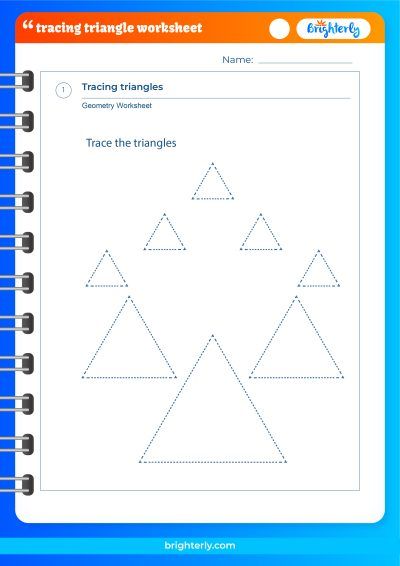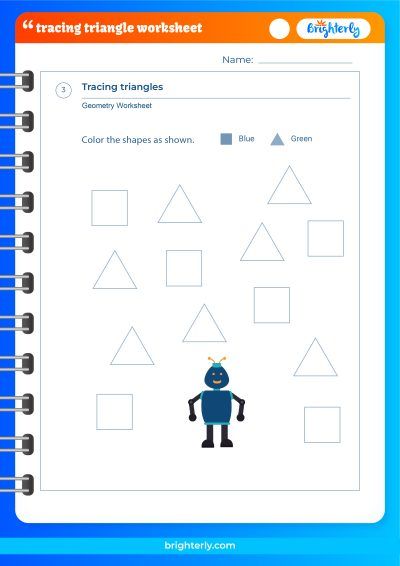Triangles – Definition, Properties, Types, FAQs, Examples
Updated on January 7, 2024
Welcome to Brighterly’s comprehensive guide on triangles! As a trusted math resource for children, Brighterly is delighted to take you on an exciting journey through the captivating realm of triangles. In this article, we will delve into the definition, properties, types, frequently asked questions, and numerous examples related to triangles.
Triangles, with their three sides and three angles, form the building blocks of geometry. Understanding the intricacies of triangles is crucial for developing a solid mathematical foundation. At Brighterly, we believe in making learning enjoyable and engaging, which is why we’ve curated this content with a touch of creativity and burstiness.
From discovering the various types of triangles, such as scalene, isosceles, and equilateral, to exploring the properties that make them unique, we will unravel the secrets of these fascinating shapes. We will also delve into essential formulas, including the perimeter and area of triangles, equipping young minds with the necessary tools to tackle geometric challenges.
What are Triangles?
Triangles are among the most fundamental shapes in geometry, defined as a three-sided polygon. The word ‘triangle’ originates from the Latin term ‘triangulum,’ which means ‘three-cornered.’ Triangles have been used throughout history for their stability and unique properties, from the pyramids of Egypt to the trusses in modern bridges. Their applicability is immense in various fields including architecture, mathematics, physics, and even graphic design.
A triangle is a polygon with three edges and three vertices. It is one of the basic shapes in geometry. To understand it better, think of drawing three straight lines on a piece of paper. If these lines intersect and form a closed shape, you have made a triangle. The area where the lines intersect are called the vertices, and each section between two vertices is called an edge or side.
Parts of a Triangle
The main parts of a triangle include three sides, three angles, and three vertices. The sides are the lines that make up the triangle. The points where the sides meet are called the vertices. Inside the triangle, the angles formed at the vertices are the interior angles. There are also exterior angles, which are formed by one side of the triangle and the extension of an adjacent side.
Properties of Triangles
Triangles have several unique properties. For instance, the sum of the interior angles in any triangle always adds up to 180 degrees. A triangle is also the only polygon that is determined by the lengths of its sides. There’s the property of inequality, which states that the length of any side of a triangle must be less than the sum of the lengths of the other two sides.
Triangle Formulas
Triangle formulas are equations involving the sides and angles of a triangle. They are used to calculate the length of sides, measure of angles, area, and perimeter of a triangle. Some common formulas include Pythagorean theorem (for right triangles), law of sines, law of cosines, and Heron’s formula (for area).
You can find the answers and more practice questions in our Triangles Practice Worksheet.
Perimeter of Triangle
The perimeter of a triangle is the total length of its three sides. It is calculated by adding the lengths of all the sides together. This is an essential concept in geometry and helps in understanding the size and dimensions of a triangle.
Area of a Triangle
The area of a triangle is the total space enclosed by its three sides. It is calculated by multiplying the base length by the height of the triangle and then dividing by two. This is also a key concept in geometry and is used in many real-world applications.
Area of Triangle Using Heron’s Formula
Heron’s formula is another method used to calculate the area of a triangle when the lengths of all three sides are known. It is especially useful when the height of the triangle is not known or cannot be easily measured. The formula is named after Hero of Alexandria, a Greek mathematician. To use Heron’s formula, you must first calculate the semi-perimeter of the triangle, then plug the semi-perimeter and the lengths of the sides into the formula.
Types of Triangles
Triangles come in different types, each with their unique properties. The classification can be based on their sides (scalene, isosceles, and equilateral) or on their angles (acute, right, and obtuse).
Scalene Triangle
A Scalene Triangle is a triangle that has all sides of different lengths. In other words, no two sides are the same length. Similarly, all the interior angles in a scalene triangle are different.
Isosceles Triangle
An Isosceles Triangle is a triangle with two sides of equal length. The two angles opposite these equal sides are also equal. The term ‘isosceles’ comes from the Greek words ‘isos’ meaning equal, and ‘skelos’ meaning leg.
Equilateral Triangle
An Equilateral Triangle is a triangle with all three sides of equal length. Because of this, all the interior angles are also equal, each measuring 60 degrees.
Acute Angled Triangle
An Acute Angled Triangle is a triangle where all three interior angles are less than 90 degrees. It’s worth mentioning that all equilateral triangles are also acute triangles.
Right Angled Triangle
A Right Angled Triangle, often simply referred to as a right triangle, is a triangle with one interior angle measuring exactly 90 degrees. The side opposite this right angle is known as the hypotenuse.
Obtuse Angled Triangle
An Obtuse Angled Triangle is a triangle with one interior angle that is more than 90 degrees. It’s called ‘obtuse’ because the angle is larger than a right angle (which measures exactly 90 degrees).
Solved Examples On Triangle
Applying triangle properties and formulas to solve problems is a key part of learning geometry. This section provides solved examples that help illustrate how to use the principles we’ve discussed to answer various triangle-related questions.
Practice Problems On Triangle
Practice is essential to mastering any concept in mathematics. This section provides a set of practice problems designed to help learners test their understanding of triangles, their properties, and their formulas. These problems range from basic to advanced, so there’s something for everyone.
Conclusion
Triangles, with their fascinating properties and diverse types, form the cornerstone of geometry. By understanding the definition, properties, and formulas associated with triangles, young learners can unlock a world of mathematical possibilities. At Brighterly, our goal is to make math enjoyable and accessible for children.
Remember, triangles are not just shapes on paper; they are prevalent in architecture, art, nature, and countless other areas. As children delve further into the world of math, they will discover how triangles play a vital role in understanding and analyzing the world around them.
At Brighterly, we encourage students to continue exploring and experimenting with triangles, embracing the joy of discovery and the satisfaction of solving geometric puzzles. With a solid grasp of triangles, young mathematicians are well-equipped to take on more complex mathematical concepts with confidence and enthusiasm.
Frequently Asked Questions on Triangles
What is the importance of studying triangles?
Studying triangles holds significant importance in mathematics and various fields. Triangles are fundamental geometric shapes that form the basis for understanding more complex geometric concepts. They help develop critical thinking, spatial reasoning, and problem-solving skills. Moreover, triangles have practical applications in fields such as architecture, engineering, physics, and computer graphics. By mastering triangles, students gain a solid foundation for further exploration of geometry and its real-world applications.
What are the different types of triangles?
Triangles can be classified based on their sides and angles. The types of triangles include:
- Scalene Triangle: A triangle with no equal sides.
- Isosceles Triangle: A triangle with two equal sides.
- Equilateral Triangle: A triangle with all three sides equal.
- Acute Angled Triangle: A triangle with all interior angles measuring less than 90 degrees.
- Right Angled Triangle: A triangle with one interior angle measuring exactly 90 degrees.
- Obtuse Angled Triangle: A triangle with one interior angle measuring more than 90 degrees.
Understanding the types of triangles helps in recognizing their unique properties and relationships between sides and angles.
How do I determine the properties of a triangle?
The properties of a triangle can be determined by examining its sides, angles, and symmetry. Here are some key properties:
- Side Lengths: By comparing the lengths of the sides, you can classify the triangle as scalene, isosceles, or equilateral.
- Angle Measures: Measuring the interior angles allows you to classify the triangle as acute, right, or obtuse angled.
- Symmetry: Triangles can exhibit different types of symmetry, such as line symmetry or rotational symmetry.
These properties provide insights into the relationships and characteristics of triangles.






